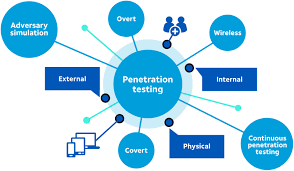Comprehensive Penetration Testing for Robust Security
Penetration testing, commonly referred to as pen testing, is an essential practice in cybersecurity aimed at identifying and mitigating vulnerabilities within an organization's systems, networks, and applications. It simulates real-world cyberattacks to assess the effectiveness of security measures and to pinpoint weaknesses before malicious actors can exploit them. In today’s digital landscape, the stakes are higher than ever, with organizations of all sizes facing relentless cyber threats. Partnering with a trusted penetration testing provider, such as Plutosec, ensures robust security and builds confidence in your defensive strategies.
The Importance of Identifying Vulnerabilities
One of the primary objectives of penetration
testing is to uncover security vulnerabilities that could lead to
unauthorized access, data breaches, or system downtime. By proactively
identifying these weaknesses, businesses can remediate them before they become
entry points for attackers. Vulnerabilities may arise from misconfigurations,
outdated software, or human error, making regular assessments critical for
maintaining a secure environment. Penetration testing also helps organizations
comply with regulatory requirements and industry standards, demonstrating a
commitment to data security.
How Penetration Testing Enhances Cybersecurity
Posture
Through simulated attacks, penetration testing reveals how an organization’s
defenses perform under real-world conditions. This approach provides valuable
insights into the effectiveness of firewalls, intrusion detection systems, and
other security measures. By addressing the weaknesses identified during
testing, businesses can strengthen their overall cybersecurity posture and
reduce the likelihood of successful attacks. Moreover, penetration testing
promotes a culture of continuous improvement, encouraging teams to stay
vigilant and proactive in safeguarding their systems.
Network Penetration Testing
Network penetration testing focuses on evaluating the security of an
organization’s network infrastructure. It identifies potential vulnerabilities
in firewalls, routers, switches, and other network components. This type of
testing is particularly crucial for organizations with complex or distributed
networks, as it ensures that sensitive data remains protected from unauthorized
access. By conducting thorough network penetration testing, businesses can
prevent lateral movement by attackers and secure their critical assets.
Application Penetration Testing
Applications are a common target for cybercriminals, making application
penetration testing a vital component of any security strategy. This process
involves examining web, mobile, and desktop applications for vulnerabilities
such as SQL injection, cross-site scripting (XSS), and insecure authentication
mechanisms. With the growing reliance on applications for business operations,
ensuring their security is paramount. Application penetration testing not only
protects sensitive user data but also safeguards an organization’s reputation
by preventing security breaches.
Cloud Security and Penetration Testing
As more organizations migrate to cloud-based environments, ensuring the
security of cloud infrastructure has become a top priority. Cloud penetration
testing evaluates the security of cloud platforms, applications, and services
to identify potential risks. This type of testing assesses configurations,
access controls, and data storage practices to ensure that cloud environments
meet security best practices. With the rise in cloud adoption, penetration
testing for cloud security is indispensable for protecting sensitive data and
maintaining compliance.
Social Engineering in Penetration Testing
Social engineering attacks exploit human psychology to gain unauthorized
access to systems or information. Penetration testing often includes social
engineering scenarios, such as phishing simulations or physical security
assessments, to evaluate an organization’s resilience against these tactics. By
identifying weaknesses in employee awareness and response, businesses can
implement targeted training programs and policies to mitigate the risk of
social engineering attacks.
Compliance and Regulatory Requirements
Penetration testing is a critical component of meeting compliance and
regulatory requirements in various industries. Standards such as the Payment
Card Industry Data Security Standard (PCI DSS), General Data Protection
Regulation (GDPR), and Health Insurance Portability and Accountability Act
(HIPAA) mandate regular security assessments to protect sensitive data. By
conducting penetration tests, organizations can demonstrate compliance, avoid
penalties, and build trust with stakeholders.
The Role of Reporting and Analysis in
Penetration Testing
A key outcome of penetration testing is the detailed reporting and analysis
provided to organizations. These reports outline the vulnerabilities
discovered, their potential impact, and actionable recommendations for
remediation. Clear and comprehensive reporting enables businesses to prioritize
security efforts effectively and allocate resources to areas with the greatest
risk. Additionally, the insights gained from penetration testing reports inform
strategic decision-making and long-term security planning.
Continuous Improvement Through Regular Testing
Cybersecurity is an ongoing process, and regular penetration testing is
essential for maintaining a strong security posture. As new threats emerge and
technologies evolve, periodic assessments ensure that security measures remain
effective. By conducting regular tests, organizations can adapt to changing
environments, identify emerging vulnerabilities, and stay ahead of potential
attackers. Partnering with experts in penetration testing, such as Plutosec,
ensures access to the latest tools, techniques, and insights for robust
security.
Conclusion
Penetration
testing is a cornerstone of a comprehensive cybersecurity strategy,
providing organizations with the insights needed to identify vulnerabilities
and strengthen defenses. By addressing weaknesses uncovered during testing,
businesses can enhance their security posture, meet compliance requirements,
and protect critical assets. The expertise of trusted providers like Plutosec
(https://plutosec.ca) ensures that penetration testing is thorough, effective,
and aligned with industry best practices. Investing in regular penetration
testing not only reduces risk but also fosters trust among customers, partners,
and stakeholders, positioning organizations for success in today’s digital
world.

.jpeg)

.jpeg)
Comments
Post a Comment